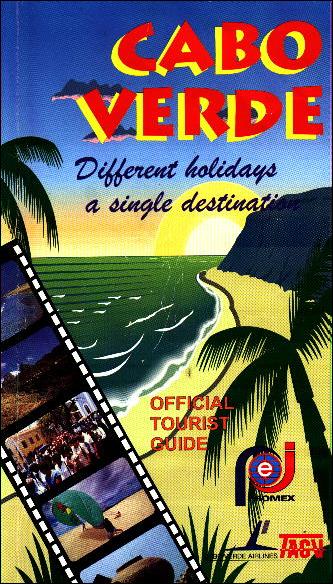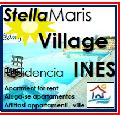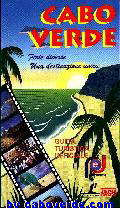
Location
MAIO beíongs to the leeward group and is located south of the isíand of
BOAVISTA and about 25 km east of SANTIAGO.
It has a surface area of 268 km2, the longest point, in a north-south direction
being 24 km and the widest point, in an east-west direction is 16 km.
The island is on the whole fairly flat, the highest point, in the middle, is Monte Penoso, with an altitude of 436 m.
The valleys are arid and dry and not very deep. Although the island is volcanic in origin, there are few signs to show it.
The climate is very dry and the land is essentially calcium based s rock. There is little irrigated land. Eventhough the climate is not particularly favourable, the island does in fact have the biggest forest park in Cape Verde. The Northern region has been well eroded by the rough seas and the strong Northeast winds.
Along the coast there are numerous and very beautiful beaches of fine golden sand.

History
The island was discovered on the 1st of May 1460 by the Portuguese navigators Diego Gomes and Antonio de Noli, and it was from the name of this month that the island "Maio" got its name.
The economic activity of the island at the time was limited basically to the breeding of goats. Later, at the beginning of the XVII century,the production of salt brought more people to the island.
As many English ships stopped here to get supplies, the port became known as Porto Inglês, which means English Port.
In the XIX century, the export of salt to Brazil greatly boosted the economy. During the XX century, emmigration began and steadily increased. Life in Cabo Verde was difficult, mainly due to the terrible droughts that hit the country year after year.

Cultural Events
Religious and other Festivals
The two most important celebratians are:
3rd of May
The May Festival, Festival of the "Santa Cruz" (Holy Cross)
24th, 25th and 26th of June
The Traditional celebrations of S.Joào
Weddings are also celebrated in a very traditianal way, with everyone getting together the night before to give presents and help in the preparations for the big day.

Handicraft
A number of cooperatives were created on the island ta develop the hand made ceramics industry. Pots and other cooking utensils are the main articles produced.

Food and Drink
The meat and fish on MAIO are extremely fresh. The specialities of the island are the following:
APPETISERS
- Melon with local cheese (of the island)
- Local cheese with dates
MAIN DISHES
- Tchassina: salted goat meat which is eaten with "cachupa"
- Stewed beans: with "feijão longo" (long beans)
- Goat stew with xeren (served at all popular feasts)
DESSERTS
- Water melon and Melon salad
- Melon fruit preserves
- Local cheese

Sports and Entertainment
MAIO has tremendous potential in terms ai tourism and its ecology is of great interest.
Pollution is something that, fortunately, has not yet reached this island.
The maritime fauna, varied and abundant will delight any fisherman.
The vast deserted beaches are the habitat of a number of species of sea birds. The turtles also use them to lay their eggs. For those who love to lie in the sun and swim all year round, nowhere could be better than these fine golden sandy beaches.
For those who prefer to find the attractions of the island by themselves, just by walking, they can discover areas of incredibly exotic vegetation - coconut trees, date palms, wild fig trees, and beautiful acacias.
The cheerful haspitality and the honesty of the local people is something that helps to make the visitor's holiday even more enjoyable.

Places to Visit
The second largest airport is on the island of MAIO, about 2 km from the town with the same name. The town itself is located right next to the sea. Near the small port is a beautiful fine sandy beach, where the local fishing boats are moored. Nearby is a fortress that was built in the XVIII century, to defend the town from the pirates. A liftle further on, and higher up, is a magnificent church, surrounded by beautiful flawer gardens. In the same region is a cooperative building very sui generis in its architecture as it is built in the form of an African hut.
A VISIT TO THE SALT PITS AND THE MORRO-MORINHO:
Although these extraordinary salt pits, 5000 m long and 1500 m wide, are no longer in use, they are well worth a visit. The vegetation in the area is very unique. Two typical species, called locally the "Marraça" and the "Salsola Soda" are the main ones to be found here.
MORRO is a small village practically built along the road side. The local handicrafts of pots and other cooking utensils are very interesting. It has a very attractive beach and its clear waters are excellent for fishing.
In the same vicinity, between Costa and Monte Batalha is a regian where there is absolutely no vegetation. The mirages that appear here make you feel as in you are in the open desert.
A little further on is CALHETA, a small fishing port. It was in this region that the infra-structures for reforestation were introduced for cattle breeding purposes.
CALHETA de BAIXO has two fine white sandy beaches, sheltered by the rock formations at both ends.
Next on the route is MORRINHO, where to the north is another salt pit separated from the sea by about 1200 m.
BAIA de SANTANA is a deserted beach in the shape of semi-circle. It is the beach that the fishermen from MORRINHO use and the turtles too are also fond of this beach.
Nearby are two more beautiful beaches, BAIA de PORTO CAIS and PRAIA REAL, where the turtles can be seen and where there is an abundance of shellfish.
A VISIT TO FIGUEIRA DA HORTA AND RIBEIRA DO JOÃO:
This trip takes the visitor into the oasis. FIGUEIRA DA HORTA is about 6 km from the town of MAIO. The scenery is truly desert like and unusually attractive. The bird-life found here, well adapted to desert conditions, feeds on insects and can go without water for long periods of time.
There is also another co-operative here in the shape of an African hut. On the road, out in the direction of Figueira Seca, there is an animal drinking trough.
RIBEIRA DE JOÃO is the final stopping point and is a truly magnificent oasis.





















